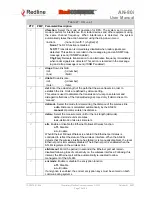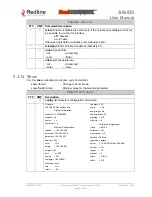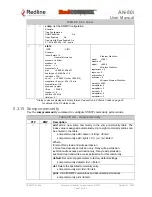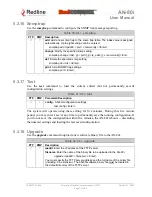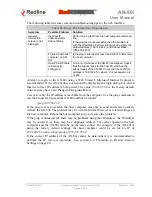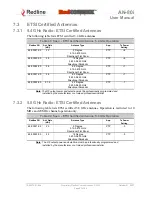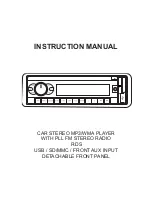
Red
CONNEX
TM
AN-80i
User
Manual
70-00072-01-04b
Proprietary Redline Communications © 2007
October 31, 2007
Page 72 of 94
Table 27: CLI - set
PTP PMP Parameter/Description
√
√
ipaddr
: Enter the IP address and subnet mask of the AN-80i.
Address
- IP Address
Mask
- Subnet Mask
Yes
- Confirmation to proceed
√
maxdst
: Maximum distance to a subscriber [Km].
<distance>
- Maximum distance from SC to SS [Km].
√
√
maxtxpower
: Enter the Tx power level (dBm).
This setting is for the transceiver output only. The actual EIRP depends on the
gain of the connected antenna. See
ETSI Certified Antennas on page 87 for a list the maximum transmit power
setting based on the antenna gain for a series of frequency settings. The
maximum value for this field is determined by the options key.
√
mgmtag
: Management VLAN enable.
<mode>
- [on | off]
√
mgmvid
: Management VLAN ID.
<vlan_id>
- <VLAN ID>
√
mrate
: Enter the maximum uncoded burst rate (Mbps). Entry values are
dependant on the channel bandwidth (chwidth).
10 MHz: 3, 4.5, 6, 9, 12, 18, 24 or 27
20 MHz: 6, 12, 18, 24, 30, 36, 48, or 54
40 MHz: 12, 24, 36, 48, 60, 72, 96, or 108
The maximum value for this field is determined by the options key.
√
√
netmask
: Enter the IP netmask.
√
√
optionskey
: Enter the options key string.
<kIdx>
- Index of the options key [0 | 1]
<kStr>
- [<options_key_string>]
√
peermac
: Peer MAC address.
<id>
- [id number]
<mac>
- <MAC address>
√
pllm:
Enable or disable prioritized low latency mode;
off
- Disable
on
- Enable
√
√
radio
: Enable or disable the radio transmitter.
off
- Disable
on
- Enable
√
ratedif
: Enter the number of modulation levels to step down during re-
transmission of errored wireless packets. The level can be set from 0 to 7
(recommended value = 2).
√
regper
: Frames number between registrations.
<frames>
- The number of frames between registrations [4..100].
√
√
rffreq
: Enter the center frequency for the RF channel. When operating multiple
links in close proximity, channel frequencies should be separated by a
minimum of the channel size to minimize interference. For example, when
operating in with 20 MHz channels, the separation must be greater than 20
MHz.













